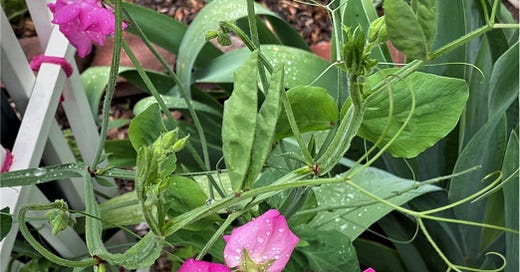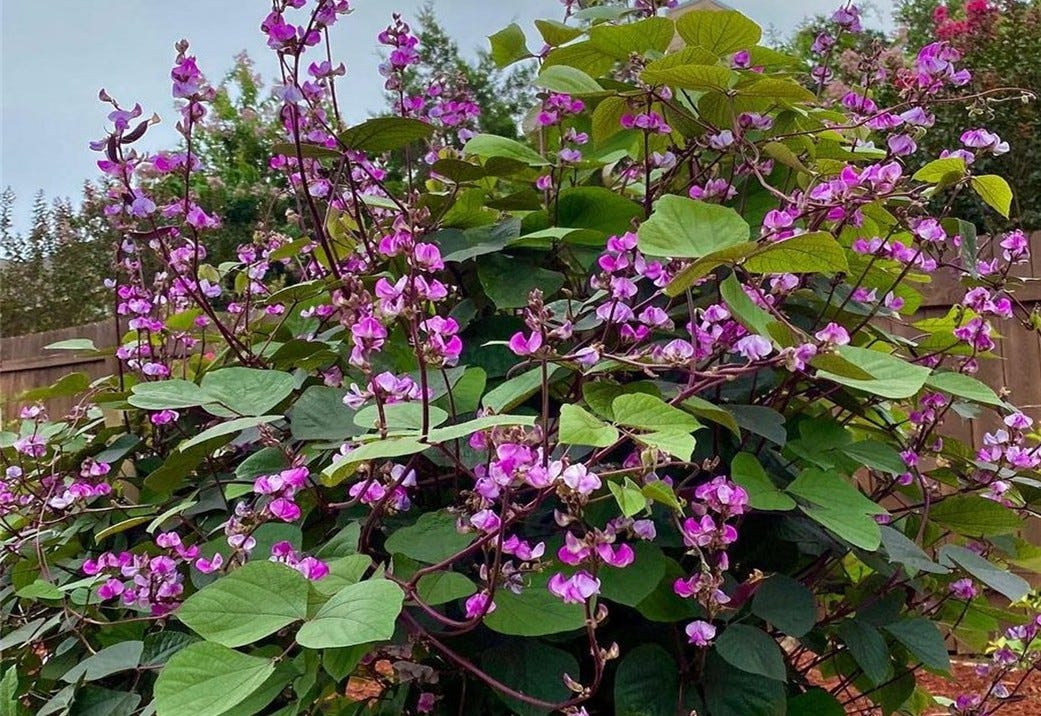Vines, along with groundcovers, are probably the most misunderstood, underrated, underused, misused, and outright abused plant types in the home garden and landscape. Because of such troubles, their popularity has faded. Too bad; they fill many niches in a well-designed landscape.
Defined as a plant whose stems require support and that “climbs” by any of a number of means; or, without support, creeps along the ground. Other than the fact that all have long, pliable stems (when they’re young, in any case), vines differ greatly. They may be annual, herbaceously perennial, or woody (“lianas,” or Tarzan’s mode of transportation). They may be evergreen, semi-evergreen, or deciduous. They may be modest in size (an uncommon group) or rampant enough to engulf trees or sometimes even houses (the more common group).
Possibly the most important difference among vines, which gardeners must know for each vine’s success, are their mechanisms and processes for climbing. Vines don’t support themselves with thick, stiff stems or trunks and branches as do other large plants, bushes, and trees. They must lean on something or grab onto something for their support. And they “lean or grab” — “climb” — using four basic methods:
by tendrils, sometimes specialized,
by clinging,
by twining, or
by simply clambering.
TENDRIL CLIMBERS have specially modified organs that grasp the host or support. Tendrils are slender, coiling structures. They are specialized plant parts growing from the end of a leaf, the side of a stem or the end of a stipule (leaf stalk).
The tendrils grow straight until they contact something that they can grasp such as wire or cord, trellis, fencing, another stem on the same vine, another plant, and then reflexively contract into a spiral and wrap around the support. The tendrils develop stronger tissue, rendering them stout enough to support the weight of the plant.
Tendrils usually won’t grab onto anything much larger than ½ inch wide. Against walls and fences where surfaces are flat, various structures, including the ever-popular trellis, are added to provide the tendrils something to grab onto. Strings and wires are not the best for supporting large perennial/woody vines. If the support is too thick, the vine will merely attach to its own stems, growing into a tangled mess.
On the other hand, tendrils cling to smaller objects better than do twiners, such as the wire netting on your fence or a twig on a host plant. Hence, these vines are excellent choices for latticework supports such as chain-link fences and lath trellises. These vines are also great growing over large shrubs or even over larger vines.
Examples: Passionflower, Grapes, Sweet Peas, Coral Vine, and Clematis (with leafy tendrils, although some consider it to be a twining vine).
There also is a specialized type of tendril vines called tendril-clingers. Many of the trumpet vines, for instance, have tendrils that end in hook-like devices that are so fine and hard they can grip onto brick and stone surfaces much as true clingers do.
CLINGING VINES climb with either disk-like adhesive tips — called holdfasts — that attach themselves to any surface (these are another kind of specialized tendril) or small aerial rootlets along the stems, rootlets that can squeeze themselves into even the tiniest crevices of a rough-textured surface
Clinging vines are a good choice when you need to cover a wide wall, especially of stone, block or brick. Vines with aerial roots will not, however, climb up metal or glass nor will they twine about a trellis.
Be aware that aerial rootlets will penetrate mortar. This can allow moisture to seep into the walls, which is damaging over time. But then again, how many houses are made of stone and mortar nowadays? Just don’t let them onto the tiles of the roof.
Some good news is that a good clothing of vining plants will protect the wall from weathering and give an extra layer of insulation.
Examples: English Ivy, Boston Ivy, Virginia Creeper. Climbing Hydrangeas, Wintercreeper

TWINERS (technically called “bines”) twist their entire stems around a support to as they grow. The growing tips of twining plants make a wide circle to increase the chances of contacting a potential support. Once they do, they cling until they reach the top.
Because of their twining habit, these vines grow best on poles or fences; they won’t grow on a wall by themselves. Some of these types, almost always the annual types or deciduous herbaceous types, are light enough to be happy on small structures. Others demand a hefty structure.
Interestingly, some twining vines grow with their stems circling in a counterclockwise fashion. Wisteria is a common example. Others circle their stems clockwise; honeysuckle for example. Do not try to train a vine to grow opposite to its natural habit.
Depending on the ultimate size and vigor of the vine, you should provide something at least 1-inch in diameter and no more than about 4 inches in diameter. Twining vines with light to moderate growth habits are also good choices for growing on open trellises with narrow cross members. Speaking of trellises, if you do find a need for such, it’s usually best to build one yourself, in some custom fashion. The tiny trellises found at retail outlets rarely do the job satisfactorily.
Examples (besides wisteria and honeysuckle): Beans, Lablab or Hyacinth Bean, Chocolate Vine (Akebia), Morning Glory, and most Jasmines.
CLAMBERERS, also called scrambling vines, have no means of attachment. They merely scramble or trail over surrounding vegetation, debris, or bare ground. They climb only in the sense that their stems will proceed on a vertical path if secured to a support as they grow.
These plants essentially throw themselves over other plants (or structures). They often use hooks, spines or prickles to prop themselves on the host. “Climbing” roses are the most familiar example. Left to themselves, they’ll simply mound, sprawl, and scramble along the ground. They need appropriate attachment and a helping hand on a regular basis.
Examples (besides roses): Bougainvillea and Arabian jasmine or Sambac (Jasminum sambac).

.
Each climbing method requires its own type of support. A two by six ornate trellis isn’t the one structure to fit all. In fact, although it will allow for a twining vine or a tendril-climbing vine, it’s size is meant for only the smallest species with those climbing methods. It’s another one of those examples of “right plant, right place.”
© Copyright, Joe Seals, 2025






